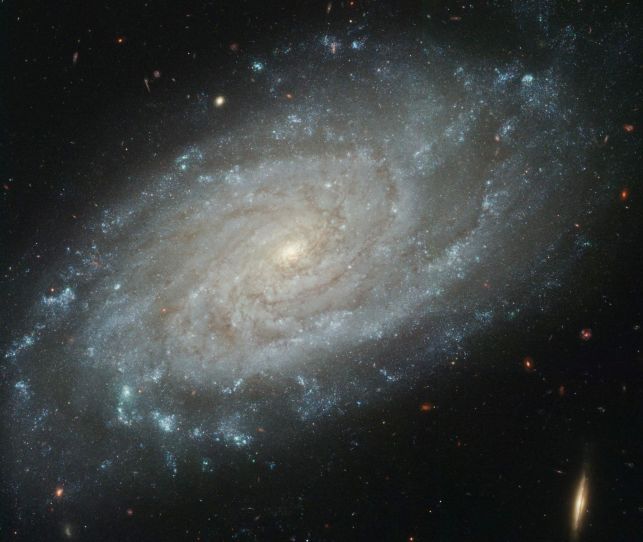Subscribe to receive new posts:
Posts Tagged ‘Milky Way’
In the Beginning and In the End
When the cosmos was about to be created — the fundamental forces of nature being unified in an exceedingly hot, dense point and galaxies, stars, planets, even stable matter itself yet unformed — there was no recognizable space, no measurable time. There was no darkness over the surface of the deep because there was no deep, no surface, no over and no under. No wind hovered over any water, as there was not yet any hydrogen or oxygen, much less any combination of them in the form of water. And there was no wind, either. What there was — all that there was — was chaotic, pulsating Potential.
At some moment, for reasons yet unclear, what was began to change into what is. Gravity separated first from the combined strong nuclear and electroweak forces. Then the strong force emerged and the electroweak force devolved into the electromagnetic force and weak nuclear force. The nascent universe, still small and unbelievably hot and turbulent, was an ever changing soup of energy and sub-atomic particles. It was all good, and about to become better.
Within one second from the mystery of beginning, our mini-universe inflated, and then started to expand. Its temperature dropped from an unfathomably hot state of 100 nonillion degrees Kelvin to only one trillion degrees, but that relative cooling was sufficient for sub-atomic particles to become protons and neutrons and other heavier particles. At the three minute mark, with the temperature now down to a cool billion degrees, particles fused into atomic nuclei, mostly hydrogen nuclei, some helium nuclei and other kinds as well. This, too, was good. read more
Science and Judaism: One Rabbi’s Personal Theology
A few years ago on a Shabbat evening at Adat Shalom Reconstructionist Congregation in Bethesda, Maryland an almost surely unprecedented event occurred. Through the magic of the Hubble Telescope, the internet, and the digital projector, congregants were able to see large images of the vast, exploding universe in which we are all suspended. As the images were paraded one by one before the amazed eyes of the congregants, Steve Brody, an Institute for Science and Judaism Board member and astrophysicist, identified and explained them. Some were familiar; most were not.
There were galaxies, clusters of galaxies, clouds of interstellar gas in which stars are being created, dying stars, and the remains of a supernova. While Steve explained the scientific significance of these denizens of space, a rabbi declaimed passages from the Tanach, our Hebrew Bible. In apposition to a photograph of the Milky Way in which the profusion of stars that comprise it appeared in all their glory, the rabbi quoted God’s promise to Abraham:
[God] took him outside and said “Look toward heaven and count the stars,
if you are able to count them.”
And He added “So shall your offspring be.” read more
Science and Judaism: WWMD? What Would Maimonides Do?

Credit: NASA AS8-14-2383
Rabbi Moshe ben Maimon, Maimonides, also known by the acronym Rambam, lived just over eight hundred years ago (1138-1204 CE). He never saw the planet Earth as astronaut William Anders did on December 24, 1968 when module pilot Anders took the now iconic photograph above while flying over the lunar surface during the first manned orbit of the Moon. We do not know if Maimonides even imagined such a sight.

Credit: NASA/JPL P41508
The picture above shows Earth with the Moon in the background. This scene was captured by the Galileo Orbiter on December 16, 1992 at a distance of almost four million miles from our home planet. Maimonides never had the opportunity to see Earth and Moon from this perspective either.
Credit: NASA, The Hubble Heritage Team and A. Riess (STSci). PRC2003-24.
Living some four hundred years before Nicolaus Copernicus considered the nature of the solar system and Galileo Galilei fashioned his first telescope, Maimonides did not realize that the Earth circled the Sun, and not the other way around as was commonly understood in his day. Nor could he have known that the Sun was but one medium sized star in a rather unremarkable galaxy known as the Milky Way which spans 100,000 light years and is similar in size and shape to the spiral galaxy NGC 3370 shown above in a picture taken by the Hubble Space Telescope. Similarly, he would not have known either that our galaxy consisted of a few hundred billion stars, give or take, or that the Milky Way was but one of perhaps a hundred billion galaxies, give or take, in the visible universe. See Tyson and Goldsmith, Origins (W.W. Norton, 2005), at 27, 150. read more



